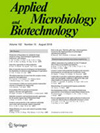The Journal publishes the following types of articles: Original papers with a maximum length of 6 printed pages including figures tables and references (about 18 manuscript pages typed double-spaced). Short contributions that do not exceed 2-3 pages in length including tables figures and references. Mini-reviews with a maximum of 5 printed pages. Papers should deal with the following aspects of applied microbiology and biotechnology excluding pure biochemical articles: Mini-review - Short reviews describing biotechnological products or the current state of relevant processes for the biotechnological production or degradation of compounds or biotechnologically relevant methods or bioreactors and other equipment used for biotechnological processes. Biotechnology - Processes of biotechnology industry all biotechnological processes using cultures of prokaryotic or eukaryotic cells enzymes or biosensors applying immobilization techniques or new bioreactors to obtain biotechnological products and the characterization of the engineering or kinetics of these processes. Biochemical and process engineering - All biotechnological processes using free or immobilized enzymes and other proteins for the production conversion and degradation or detection of substances respectively. This includes the application of either wild type of modified enzymes and proteins. Papers reporting only the purification or characterization of enzymes of biotechnological interest will be restricted to hitherto undescribed enzymes and to enzymes which are significantly different to known enzymes. Applied genetics and molecular biotechnology - All aspects of research and development related to biotechnological processes metabolic engineering and biotechnological aspects of genetic control that employ the development of microbial strains and strain improvement by cell fusion or classical and molecular techniques including recombinant DNA technology. Applied microbial and cell physiology - All fields of applied microbiology with respect to biotechnology excluding medical and food microbiology. Included are production of primary and secondary metabolites biopolymers transformations by microorganisms microbial energy production utilization of renewable resources conversion of substrates degradation of substances and control of microbial processes. Environmental biotechnology - Covering microorganisms and their physiology in biotechnological processes that are employed in sewage purification treatment of sludges waste and refuse biotechnological soil decontamination degradation of xenobiotics and other problematic substances bioremediation biotechnological gas purification corrosion of materials and biodegradation of polymers and biodeterioration including the technology of such processes. Theoretical treatments will be
